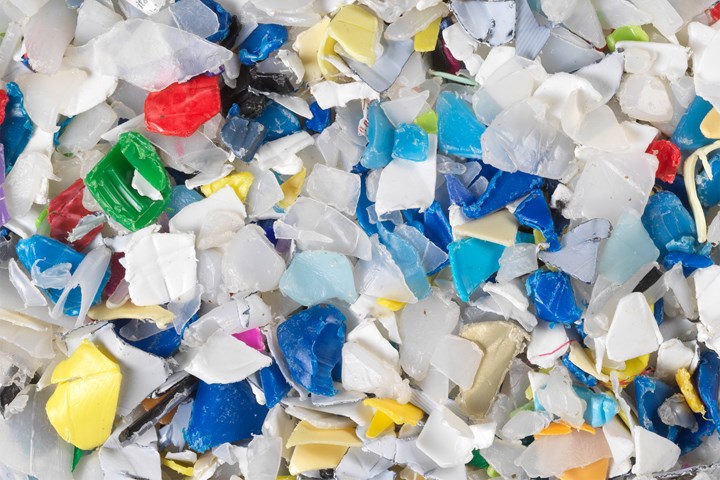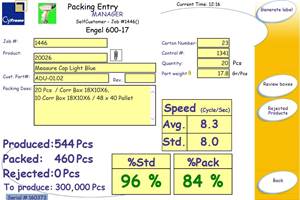Looking to Run PCR on a Single Screw? Here’s What to Keep in Mind
Just drop it in and mix it up? Sorry, there’s a lot more to it than that. Here is some of what you need to consider.
I get a lot of questions from extrusion processors about whether they can run mixed post-consumer reclaim (PCR) their single-screw extruders. With those questions in mind, here are a few things you need to remember if this kind of extrusion is part of your plan moving forward.

Extruding mixed-plastic waste on a single screw is no simple matter. Thorough pre-blending before extrusion is essential, and addition of a mixing section on the extruder might help. But the nature of the plastics to be mixed is probably the most crucial factor. (Photo: Starlinger)
Cleaning Comes First
First of all, the scrap must be clean — not just of solid contaminants, but also of oils, lubricants and residual chemicals. That said, even running completely clean mixed-plastic waste on single-screws has limitations. It’s not like alloying metals. Unlike metals — whereby mixing different metals through melting can make alloys that may have substantial performance improvements — many plastics are simply not miscible with one another due to their molecular structure. Generally, amorphous polymers can be more easily extruded into workable products than can crystalline polymers, simply because amorphous resins have no crystalline structure to block intermixing. However amorphous polymers make up such a small part of the PCR stream that they are relatively inconsequential to recycling.
To get the best possible results on a single-screw extruder, regardless of the polymers involved, make sure that clean mixed scrap is finely ground and thoroughly blended before feeding it to the extruder. Single screws are pretty much continuous-flow devices that have very limited redistribution capability. In other words, the polymer melt does not “slosh around” in the screw like a fluid. Redistributive mixing is pretty much limited to the volume in one channel. That means that improved mixing must be based on very small, well-blended particles entering the extruder. Trying to sidestep those restrictions will greatly limit the chance of single-screw mixing.
Different Mixes
What about using multiple and aggressive mixing sections to improve mixing? Typically, these devices divide the melt into many flow paths and increase the shear stress on the polymer melt. That may provide some “macro” mixing of the various polymers in the melt. But again, many polymers are not simply miscible with other polymers, and even extremely high-shear mixing cannot force them together.
To get the best possible results on a single-screw extruder, make sure that clean mixed scrap is finely ground and thoroughly blended before feeding it to the extruder.
Also, since mixing sections are always placed where the polymer is mostly (or fully) melted, their purpose is to further divide and shear the mixture. That creates a resistance to flow, or a pressure drop, which reduces the extruder output and raises the melt temperature. Despite that extensive division and shear, a viscous melt has little capability to divide larger particles into smaller pieces. Instead, they simply change their shape to pass through the mixing device due to the applied shear, but largely remain full size.
Applying shear equally to the mixture of polymers is very difficult, as they vary immensely in viscosity at similar temperatures. That means the lower-viscosity portion will get some redistribution and shear stress, but the higher-viscosity portion will simply “float” along in the low-viscosity portion. It’s like trying to mix grease in water. Different polymers at the exact same temperature can vary in viscosity by as much as 10:1, making incorporation of one polymer into another extremely difficult even if there is some compatibility.
Other Considerations
The differences in polymer properties are so broad that a whole host of properties — such as melting point, density, shrinkage, specific heat and many mechanical properties — affect the components of a mix. So it’s difficult to obtain an “alloy” even if it could be successfully mixed.
Any discontinuity in the final mix typically compromises the mechanical properties of the final extruded part.
All this said, many different amorphous polymers can be mixed successfully. Even some crystalline polymers can be mixed easily because of the similarity of their molecular makeup. For example, LLDPE and HDPE can be mixed without high shear to make an alloy without limiting output. But some amorphous polymers such as PVC cannot be mixed with most other polymers without severe loss of properties and degradation and no synergistic improvement in properties.
The current developments in additive manufacturing have revealed a lot about the compatibility characteristics of different polymers. A reference to their weldability charts for different polymers is a good starting point to see if the mixture you are considering has the potential for mixing.
ABOUT THE AUTHOR: Jim Frankland is a mechanical engineer who has been involved in all types of extrusion processing for more than 50 years. He is now president of Frankland Plastics Consulting LLC. Contact jim.frankland@comcast.net or (724)651-9196.
Related Content
Understanding Melting in Single-Screw Extruders
You can better visualize the melting process by “flipping” the observation point so the barrel appears to be turning clockwise around a stationary screw.
Read MoreTroubleshooting Flow Surging in Single-Screw Extruders
Surging can cause lower production rates, higher scrap rates, material degradation and higher labor costs. Here is a guide to troubleshooting this problem.
Read MoreNPE2024 Wrap-Up: Sustainability Dominates Show Floor News
Across all process types, sustainability was a big theme at NPE2024. But there was plenty to see in automation and artificial intelligence as well.
Read MoreUse Interactive Production Scheduling to Improve Your Plant's Efficiencies
When evaluating ERP solutions, consider the power of interactive production scheduling to effectively plan and allocate primary and secondary equipment, materials and resources on the overall production capacity of the business and conclude that this is a key area that cannot be overlooked.
Read MoreRead Next
People 4.0 – How to Get Buy-In from Your Staff for Industry 4.0 Systems
Implementing a production monitoring system as the foundation of a ‘smart factory’ is about integrating people with new technology as much as it is about integrating machines and computers. Here are tips from a company that has gone through the process.
Read MoreFor PLASTICS' CEO Seaholm, NPE to Shine Light on Sustainability Successes
With advocacy, communication and sustainability as three main pillars, Seaholm leads a trade association to NPE that ‘is more active today than we have ever been.’
Read More
.jpg;width=70;height=70;mode=crop)


















